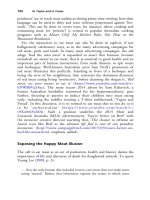The palgrave international handbook of a 235
Bạn đang xem bản rút gọn của tài liệu. Xem và tải ngay bản đầy đủ của tài liệu tại đây (26.22 KB, 1 trang )
230
J. Maher and T. Wyatt
journeys may take many hours or several days. During these long journeys,
animals may be kept outside or in areas where they are subjected to extreme
fluctuations in temperatures. Often they are not able to eat or drink, and
the spaces they are in are very dark and filled with loud noise (Wyatt
2013b). To reiterate, these are minimum welfare standards when the trade
is legal—so stress and potential suffering will always be a factor in the
wildlife trade.
In the IWT, where there are no protective measures, it is likely the
conditions are much worse, particularly when live animals must be kept
hidden. The wildlife must somehow be made to be calm, which most likely
involves tranquilising drugs or physical methods to subdue them. In the case
of endangered birds such as raptors, this may mean sewing their eyelids shut
and being tightly swaddled, so they can fit in tubes or other containers to
hide them (Wyatt 2011). Wildlife are then carried on people’s bodies or in
suitcases to be smuggled across borders. The survival rate for raptors
smuggled in this way is very low—it is estimated only around 10 % survive
the journey (Lyapustin 2006). This is also true of reptiles and mammals, who
are subjected to similar circumstances while being smuggled (Maher and
Sollund 2016). Landais (2008) estimates 10 great apes have died enroute to
Egypt for every one of the great apes in captivity. Smuggling is thus
particularly harmful to great apes (GRASP 2012), but causes significant
suffering and loss of life to all wildlife targeted by this black market. Many
of these live animals are fuelling the legal demand for pets, entertainment at
zoos and circuses and for scientific experimentation. Some wildlife captured
alive will be killed to make legal and illegal wildlife products and the methods
used for killing are also abusive.
Killing
Animals can be killed in straightforward ways with the use of weapons like
guns and bows and arrows. This may be the case when hunting rhino,
elephants or game animals. Animals that are captured with traps and so
forth, as mentioned above, may be killed in other ways like bludgeoning or
having their throats slit. Fur-bearing mammals and wildlife consumed as
bushmeat are often killed in these ways. Consumption of some wildlife
products entails even more suffering whilst the wildlife is being killed. For
instance, pangolins, which are in high demand as an exotic meat and as an
ingredient in traditional medicines, are boiled alive when made into soup
(Pantel and Anak 2010). In another example, not all rhinos are simply shot









